Starfish
Asteroidea
Has a seawater-based vascular system instead of blood
Advertisement
Starfish Scientific Classification
- Kingdom
- Animalia
- Phylum
- Echinodermata
- Class
- Asteroidea
- Scientific Name
- Asteroidea
Read our Complete Guide to Classification of Animals.
Starfish Conservation Status
Starfish Facts
- Prey
- Mollusks
- Main Prey
- Crustaceans, Worms, Sea Urchins
- Group Behavior
- Solitary
- Fun Fact
- Has a seawater-based vascular system instead of blood
- Estimated Population Size
- unknown
- Biggest Threat
- coral reef destruction
- Most Distinctive Feature
- Bumpy, spiny skin
- Other Name(s)
- Sea star
- Gestation Period
- 4-8 weeks
- Habitat
- coral reef
- Predators
- Fish, birds, turtles, otters, carbs
- Diet
- Carnivore
- Average Litter Size
- 1,000,000
- Lifestyle
- Solitary
- Favorite Food
- Crustaceans
- Type
- Asteroidea
- Common Name
- Starfish
- Number Of Species
- 2000
- Slogan
- Has 2 stomachs to aid digestion!
View all of the Starfish images!

Starfish, also known as sea stars, are some of the most important members of the underwater kingdom.
Although they aren’t technically fish, sea stars are animals that are still present in nearly every coastal habitat and can be found as low as the abyssal layer. You can identify a starfish by its bumpy skin and flat center surrounded by long limbs that give the appearance of a star.
These slow-moving but sensitive fish come in a wide array of colors; although you should never pick one up, trying to find starfish along the beach is a wonderful seaside activity.
5 Incredible Starfish Facts!
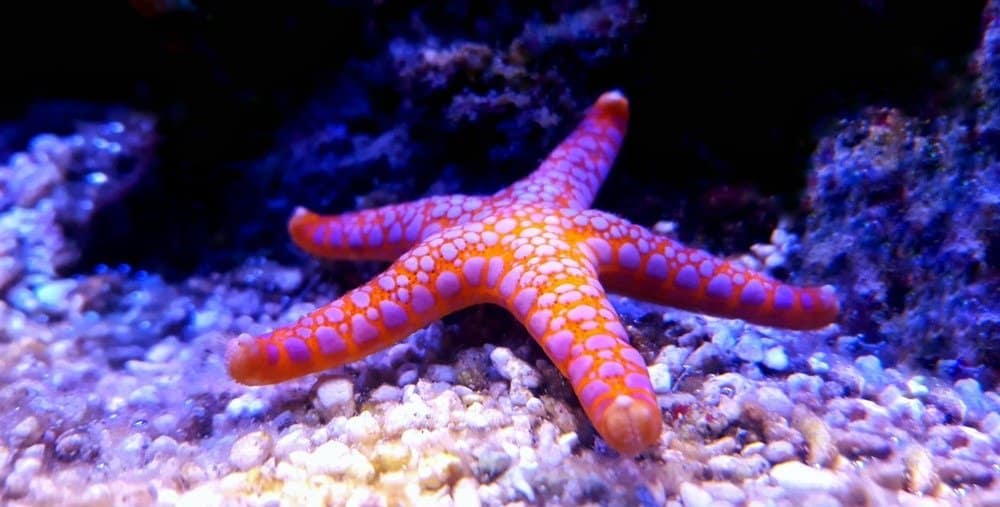
Starfish are animals that are made up of a fragile network of thin muscles and tiny ligaments.
©Vojce/Shutterstock.com
- Delicate structure: Starfish are animals that are made up of a fragile network of thin muscles and tiny ligaments. This is why they move so slowly – and also why they shouldn’t be handled.
- Extended senses: Starfish do not have a central nervous system; instead, their entire body is made up of a collection of sensory nerves. Starfish observe the world through small eyes located at the ends of their “arms.”
- Natural regeneration: Starfish possess the ability to regrow a limb that is lost. This process is slow, and it only occurs if the starfish survives the pain of the initial break. Some species of starfish can break off their own limbs in order to escape from predators.
- Vascular system: Starfish don’t actually have blood in their bodies. Instead, they pump seawater through their vascular structure in order to carry nutrients and oxygen.
Evolution and Origins
Starfish also known as Asterozoans are a diverse and ecologically successful group of spiked-skinned echinoderms that happened to first appear in fossil records close to 500 million years ago. They appeared in the Ordovician period. In fact, starfish are the most primitive member of the Asterozoan family. Additionally, the five arms of starfish are leftovers from these ancient ancestors.
Today, starfish are found all over the world in different tropical coral reefs, coastal waters, and the world’s oceans. Not only that, but starfish most likely evolved from ancient animals called crinoids.
Although ancient fossils reveal starfish have been around for a very long time, due to pollution and other man-made reasons, starfish risk a decline in population numbers.
Classification and Scientific Name
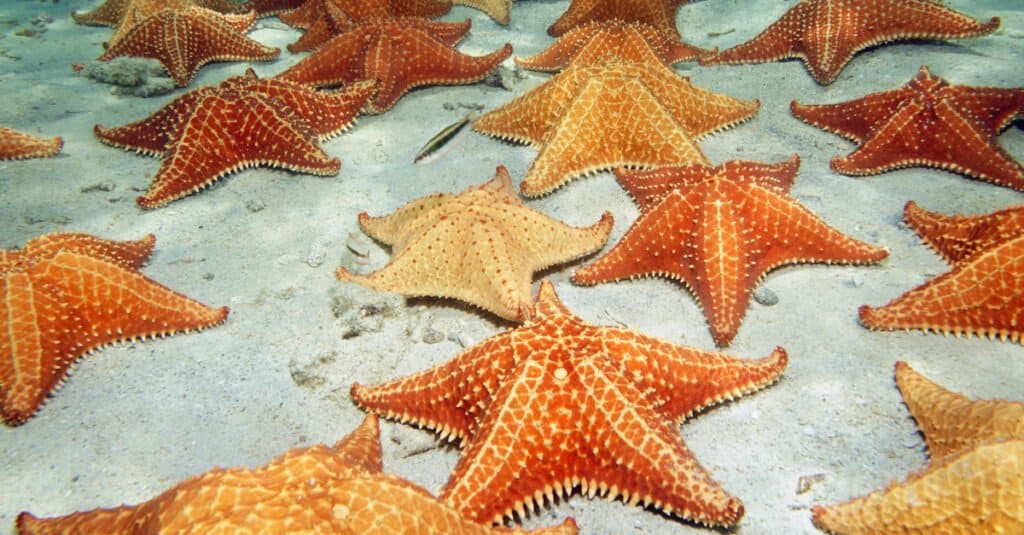
The aquatic animal that is commonly known as a starfish is also frequently called a sea star. All of these animals fall into the class
Asteroidea.
©Damsea/Shutterstock.com
The aquatic animal that is commonly known as a starfish is also frequently called a sea star. All of these animals fall into the class Asteroidea; in the scientific community, they are frequently known as asteroids. The zoological name Asteroidea translates to “star-shaped – “aster” means “star,” and “eidos” refers to “shape.”
Asteroidea is one of the largest classes in the Echinodermata family. Other echinoderms include sea urchins, sea cucumbers, and sand dollars. Most echinoderms have the same five-pointed structure as common sea stars, but plenty of these animals – including some of the different types of starfish – are capable of having far more complicated structures.
Species

There are over 2,000 distinct species of starfish, and more are frequently discovered during oceanic research.
©Millie Bond – Copyright A-Z Animals
There are over 2,000 distinct species of starfish, and more are frequently discovered during oceanic research. The many types of these animals are as varied as the different places where they are found.
With so many bright colors and creative forms, it’s no surprise that so many sea stars have colloquial and zoological names that express their unique types of beauty.
Some of the most notable types include:
- Common starfish: Asterias rubens is a simple, five-pointed animal with a peachy orange color. Also known as sugar starfish, you can find these aquatic animals all along the Atlantic coast.
- Sunflower starfish: Pycnopodia helianthoides is found in the Pacific ocean. These sea stars can have up to 24 limbs and come in all different types of colors.
- Royal starfish: Astropecten articulatus live in the West Atlantic. Like sugar starfish, they have five points; however, they are distinguished by their bold purple and orange colors.
- Necklace starfish: Fromia monilis are a West Pacific starfish named for the plates on its body, which look a lot like the beads on a necklace. In some areas, they’re known as tiled starfish.
- Chocolate chip sea stars: Protoreaster nodosus are found in the Pacific Ocean near Indonesia. These animals can be recognized by their black spikes, which look like chocolate chips.
Appearance
Starfish are flat aquatic animals that move slowly and stick to the ocean floor. Most of them have a central disk surrounded by five or more arms. The mouth is usually located in the middle of the disk, and the ends of their arms feature light-sensitive eyespots. The skin is covered in small spines, and the bottom of its limbs is usually lined with hundreds of small tubular feet that are used for gradual movement.
Starfish are animals that come in an amazing array of colors and variations. From bold purple stripes to pointed black horns, there’s no limit to the different types you might find. There are small species that are only an inch or two across, and there are large starfish that can get as big as a foot. Every region is different; you may need to take a walk along the beach to see your local sea stars.
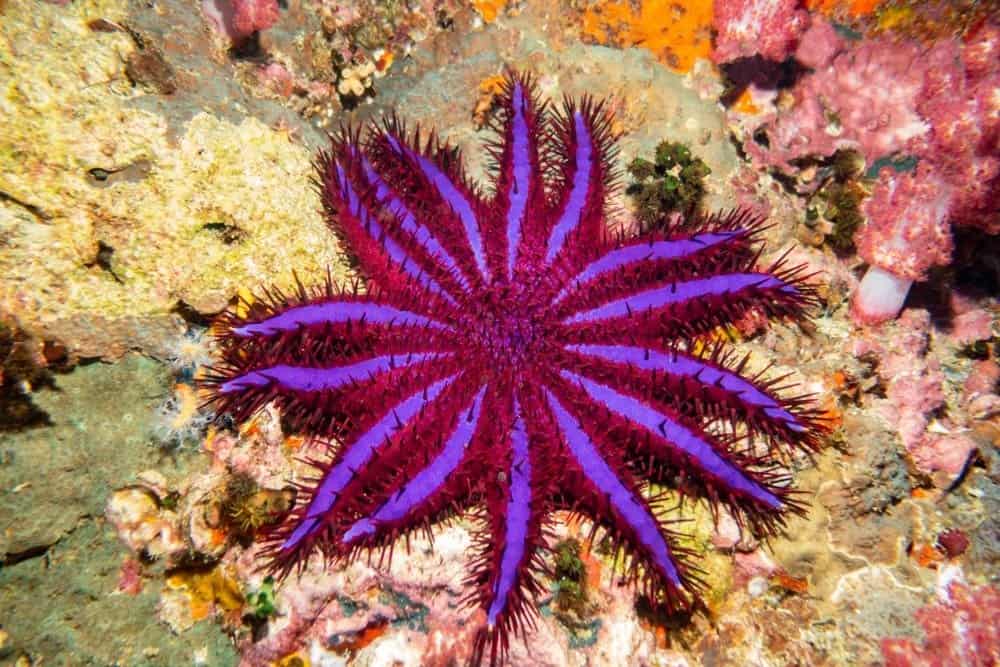
Crown of Thorns Starfish (Purple Variant) Thailand
©dvlcom/Shutterstock.com
Distribution, Population, and Habitat
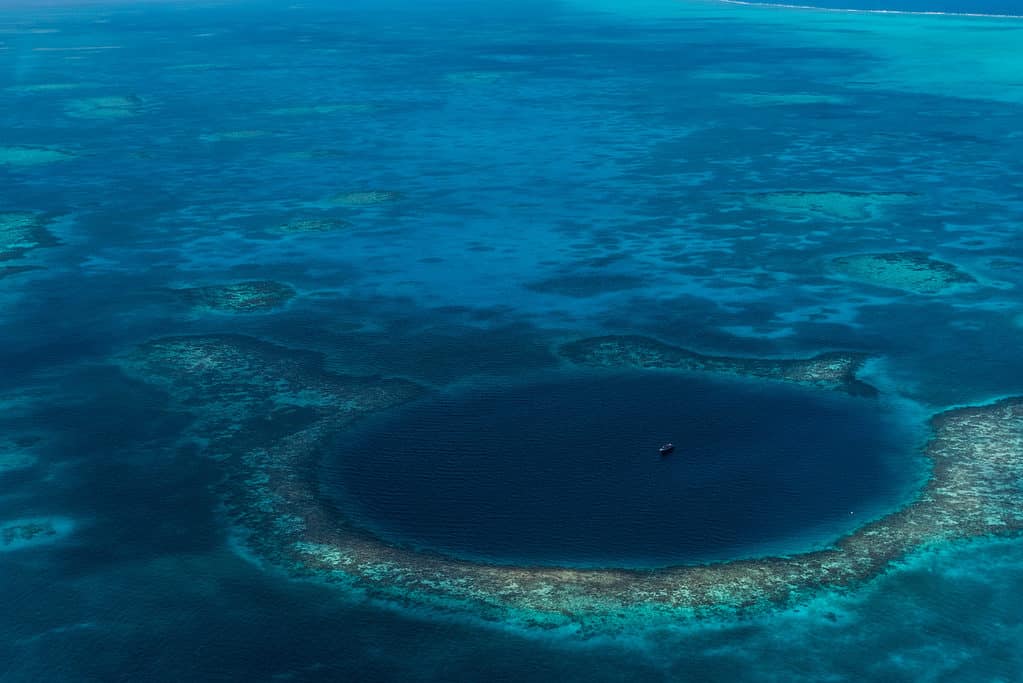
Starfish are found along every coast in the world.
©iStock.com/hartmanc10
These animals are found along every coast in the world. Because they use seawater as part of their vascular system, they cannot live in any type of freshwater. You can find them in coral reefs, muddy bays, underwater kelp forests, and pretty much every other kind of aquatic environment.
Although there are starfish all over the world, this species is still considered to be near threatened. Human presence has destroyed many of the coral reefs that house the world’s different starfish species. These animals are incredibly important to their local ecosystems, and the recent decline of their species has threatened the biodiversity of many different regions.
Diet: Predators and Prey
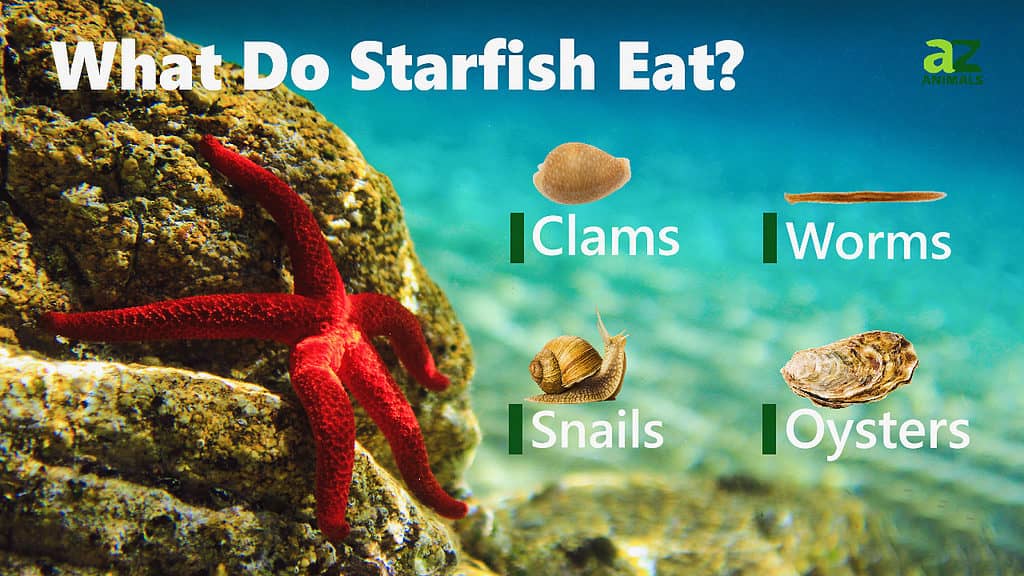
These animals are carnivores that consume nearly all types of small ocean life. Depending on where they live, they may eat mussels, oysters, clams, sea snails, fish, and even other starfish.
These animals are also seen as prey by many different types of ocean-faring life. Mammals like seals and otters may choose to eat them as a snack; other threats include birds, crabs, and large carnivorous fish.
Reproduction and Lifespan

Holding Baby Starfish over the Florida Waters
©Cowen Duggar/Shutterstock.com
These animals are solitary creatures, but they come together in large groups for mating purposes on a semi-yearly basis. They typically mate by pairing off with an opposite-gender partner. Both sea stars will release a spawn cloud into the water; once the eggs are fertilized, they will drift to the ocean floor.
These animals do not appear to care for their young after the eggs are laid. The embryos hatch before they are fully developed; as the young grow, they will slowly gain limbs and assume their adult form. These animals can live to be up to 40 years old and will continue to develop and regrow their limbs as they age.
Fishing and Cooking
These animals have not eaten as a staple food anywhere in the world. Some exotic restaurants sell fried starfish; however, between the fact that they are naturally toxic and the various state- and federal-level regulations on the sale of this sea animal, these restaurants are seldom profitable enough to continue providing them as a product.
View all 293 animals that start with SStarfish FAQs (Frequently Asked Questions)
Where are starfish found?
Starfish are found at the borders of all of the world’s oceans. Although they are most commonly found in coral reefs, you can also find sea stars hidden among other forms of aquatic vegetation, including seagrass meadows and kelp forests.
What is the scientific name of a starfish?
The scientific name for starfish is Asteroidea. There are nearly 2,000 different species of starfish, all with their own unique names.
What do starfish eat?
Starfish are carnivores that eat other forms of aquatic life that are smaller than their mouths. The diet of every starfish varies based on the species and location; however, most starfish eat things like mollusks, small fish, and seaweed.
Can you eat starfish?
Most types of starfish are inedible. Even the ones that aren’t toxic contain foul-tasting flavinoids known as saponin; if you put a piece of starfish in your mouth, it will immediately taste foul and bitter.
How long do starfish live?
Starfish is an incredibly long-lived form of aquatic life; it’s not unusual for a sea star to live as long as 40 years in the wild.
How do starfish reproduce?
Starfish reproduce by releasing spawn clouds. The male and the female starfish typically release their clouds at the same time, thus allowing the eggs to be fertilized.
Are starfish dangerous?
Starfish pose no danger to humans, but humans pose plenty of danger to starfish. If you see a sea star in the wild, don’t touch it; these delicate creatures are sensitive, brittle, and fragile.
Are starfish really fish?
Starfish do not technically meet the scientific qualifications for “fish;” they lack gills, fins, scales, or any of the other identifying creatures. However, starfish still live underwater and are a normal part of the aquatic ecosystem.
Do brittle stars count as starfish?
Brittle stars, which are also known as basket stars, are not actually a type of starfish. The basket star is another kind of echinoderm that is capable of moving itself along the seafloor by using its flexible arms. The zoological name of the basket star is Ophiuroidea.
What Kingdom do Starfish belong to?
Starfish belong to the Kingdom Animalia.
What class do Starfish belong to?
Starfish belong to the class Asteroidea.
What phylum to Starfish belong to?
Starfish belong to the phylum Echinodermata.
What type of covering do Starfish have?
Starfish are covered in Spines.
What are some predators of Starfish?
Predators of Starfish include fish, birds, turtles, and otters.
How many babies do Starfish have?
The average number of babies a Starfish has is 1,000,000.
What is an interesting fact about Starfish?
Starfish have 2 stomachs to aid digestion!
How many species of Starfish are there?
There are 2,000 species of Starfish.
What is the biggest threat to the Starfish?
The biggest threat to the Starfish is coral reef destruction.
What is another name for the Starfish?
The Starfish is also called the sea star.
How many Starfish are left in the world?
The population size of the Starfish is unknown.
How fast is a Starfish?
A Starfish can travel at speeds of up to 0.6 miles per hour.
Thank you for reading! Have some feedback for us? Contact the AZ Animals editorial team.
Sources
- David Burnie, Dorling Kindersley (2011) Animal, The Definitive Visual Guide To The World's Wildlife
- Tom Jackson, Lorenz Books (2007) The World Encyclopedia Of Animals
- David Burnie, Kingfisher (2011) The Kingfisher Animal Encyclopedia
- Richard Mackay, University of California Press (2009) The Atlas Of Endangered Species
- David Burnie, Dorling Kindersley (2008) Illustrated Encyclopedia Of Animals
- Dorling Kindersley (2006) Dorling Kindersley Encyclopedia Of Animals
- Marine Education Society of Australasia, Available here: http://www.mesa.edu.au/echinoderms/echino01.asp
- Wikipedia, Available here: https://en.wikipedia.org/wiki/Starfish
- National Ocean Service, Available here: https://oceanservice.noaa.gov/facts/starfish.html
- Britannica, Available here: https://www.britannica.com/animal/sea-star

















